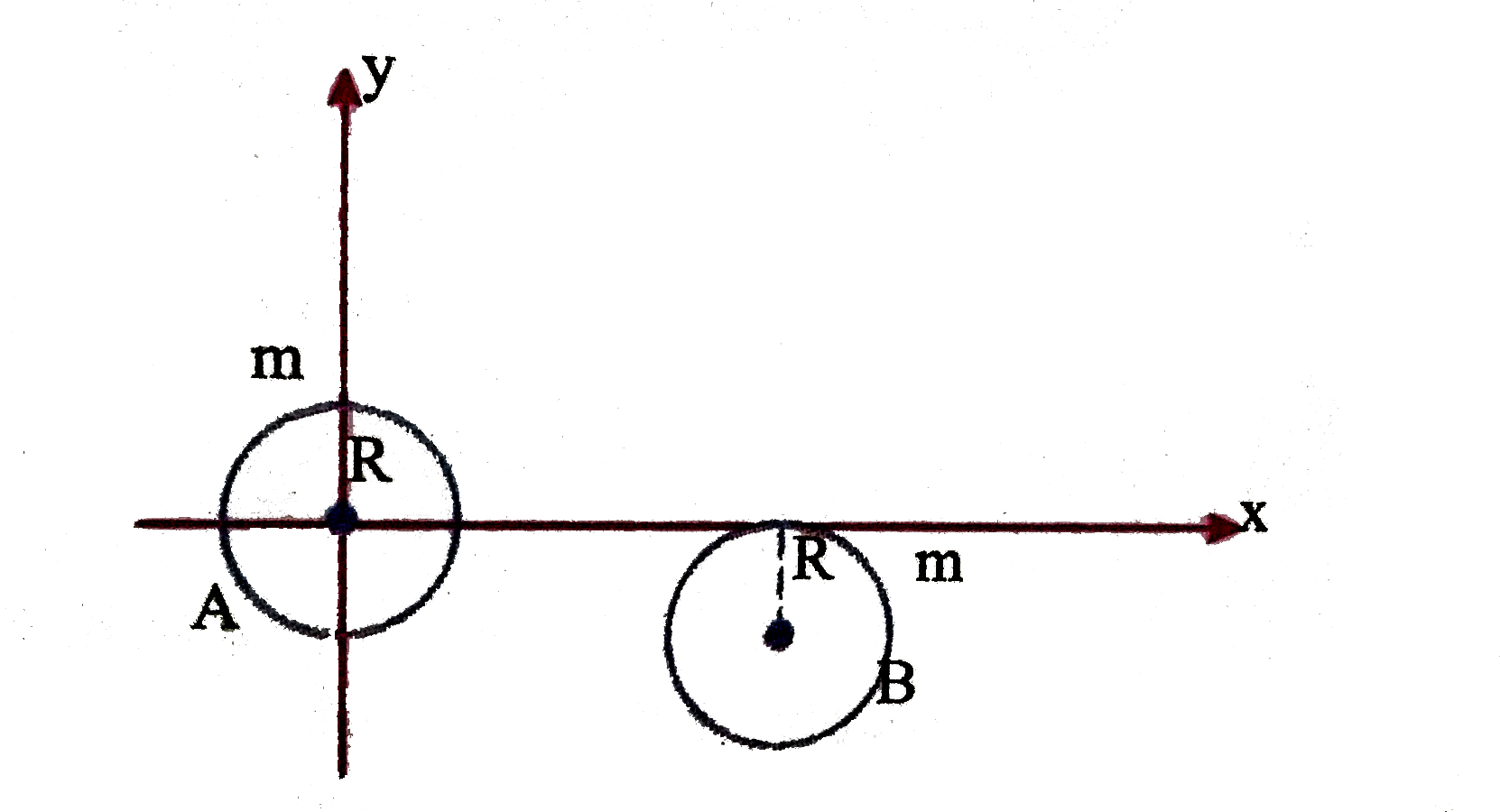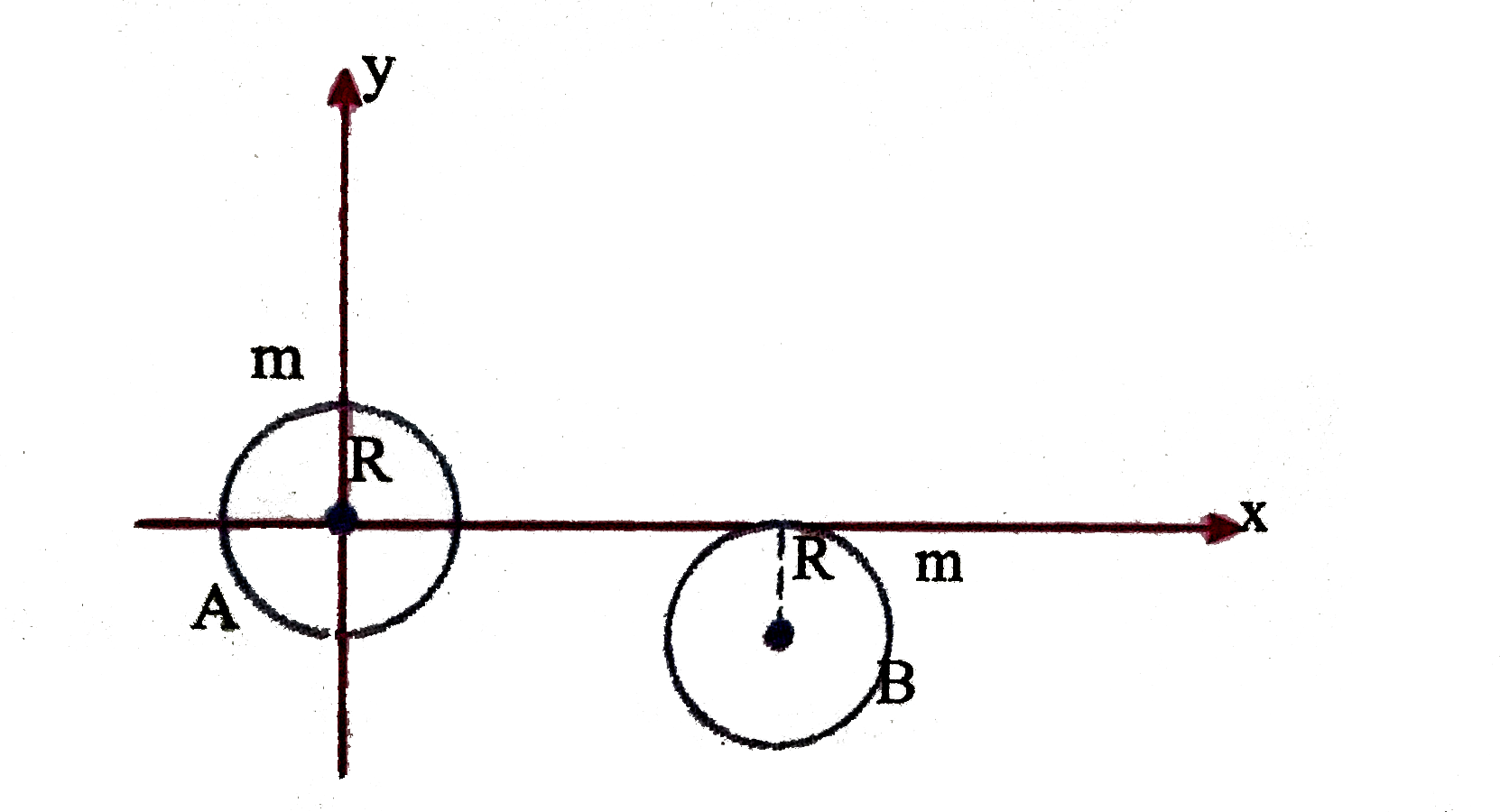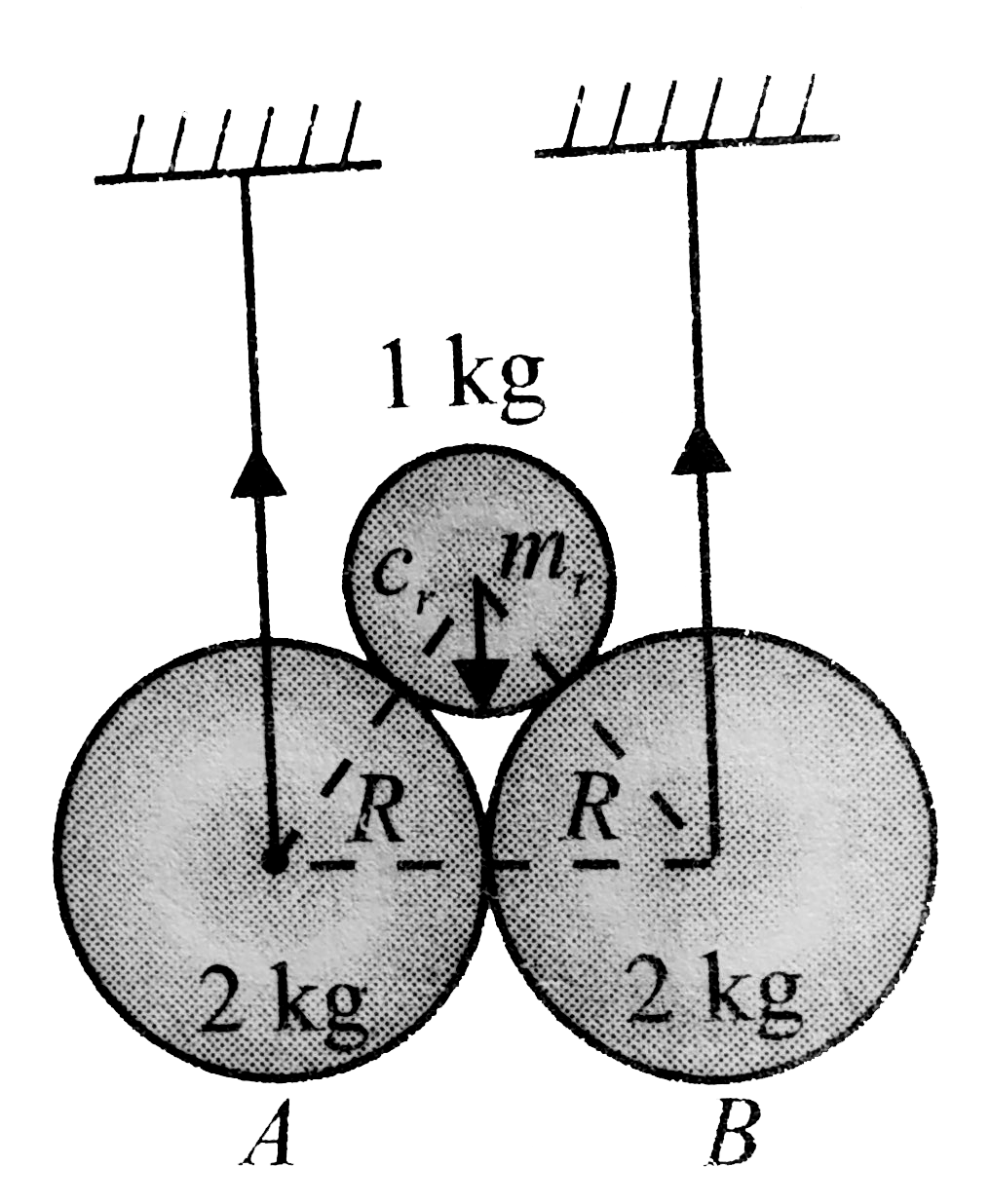Two smooth balls A and B, each of mass m and radius R, have their centres as shown in fig. Ball A, moving along positive x-axis, collides with ball B. Just before the collision, speed of ball 'A' is 4m/s and ball 'B' is stantionary. The collision

Impluse of the force exerted by 'A' on 'B' during the collision is equal to
(√3mˆi+3mˆj)kg−ms
(√32mˆi−3mˆj)kg−ms
(3mˆi−√3mˆj)kg−ms
(2√3mˆi−3mˆj)kg−ms
The correct Answer is:C

velocity of ball 'A' after collision is
=4sin30×cos60ˆi+4sin30×sin60ˆj
=(ˆi+√3ˆj)m/s
Along common normal direction velocity of ball after collision is '0'
e=v2−v1u1−u2,1=v2−v14cos30−0
v2−v1=2√3 ........(1)
m×4cos30=mv1+mv2
v2+v1=2√3 ........(2)
From (1) & (2) v1=0
v2+v1=2√3,v2−v1=2√3
⇒2v2=44√3,v2=2√3
Impluse of the force exerted by A and B
=m[4cos30(cos30ˆi−sin30ˆj)]
=(3mˆi−√3mj)kg−m/s,12=v2−v14cos30
v2−v1=√3 ........(1)
m×4cos30=mv1+mv2
v2+v1=2√3.........(2)
v2=3√32m/s,v2=3√32[cos30ˆi−sin30ˆj]
v2=(94ˆi−3√34ˆj)
Topper's Solved these Questions
- COLLISIONBook:NARAYNAChapter:COLLISIONExercise:Subjective type Questions
Explore 9 Videos
- COLLISIONBook:NARAYNAChapter:COLLISIONExercise:Level-I (H.W)
Explore 52 Videos
- COLLISIONBook:NARAYNAChapter:COLLISIONExercise:Multiple Answer
Explore 11 Videos
- CIRCULAR MOTIONBook:NARAYNAChapter:CIRCULAR MOTIONExercise:LEVEL II(H.W)
Explore 51 Videos
- FRICTIONBook:NARAYNAChapter:FRICTIONExercise:Passage type of questions I
Explore 6 Videos
Similar Questions
The figure below shows three identical balls A , B and C. Initially , the baiis B and C are at rest and the ball A while moving with a veiocity v, collides with ball B. if the collision is perfectiy elastic , then after the collision

View SolutionTwo smooth balls A and B, each of mass m and radius R, have their centers at (0, 0, R) and at (5R, -R, R) respectively, in a coordinate system as shown. Ball A, moving along positive x axis, collides with ball B. Just before the collision, speed of ball A is 4m/s and ball B is stationary. The collision between the ball is elastic.

Impulse of the force exerted by A and B during the collision, is equal to
View Solution
Knowledge Check
Two smooth balls A and B, each of mass m and radius R, have their centres as shown in fig. Ball A, moving along positive x-axis, collides with ball B. Just before the collision, speed of ball 'A' is 4m/s and ball 'B' is stantionary. The collision

Velocity of the ball 'A' just after the collision isA(i+√3ˆj)m/sB(i−√3ˆj)m/sC(2i+√3ˆj)m/sD(2i+2ˆj)m/sTwo smooth balls A and B, each of mass m and radius R, have their centres as shown in fig. Ball A, moving along positive x-axis, collides with ball B. Just before the collision, speed of ball 'A' is 4m/s and ball 'B' is stantionary. The collision

What is velocity of ball 'B' after collision isA(3ˆi−√3ˆj)m/sB(2√3ˆi−2√3ˆj)m/sC(2ˆi−2√3ˆj)m/sD(√3ˆi−√3ˆj)m/sTwo smooth balls A and B, each of mass m and radius R, have their centres as shown in fig. Ball A, moving along positive x-axis, collides with ball B. Just before the collision, speed of ball 'A' is 4m/s and ball 'B' is stantionary. The collision

Coefficient of restitution during the collision is changed to 12, keeping all other parameters unchanged. What is the velocity of the ball 'B' after the collision.A12(3√3ˆi+9ˆj)m/sB14(9ˆi−3√3ˆj)m/sC(6ˆi+3√3ˆj)m/sD(6ˆi−3√3ˆj)m/s
Two smooth balls A and B, each of mass m and radius R, have their centre at (0,0,R) and (5R,-R,R) respectively, in a coordinate system as shown. Ball A, moving along positive x-axis, collides with ball B. Just before the collision, speed of ball A is 4m/s and ball B is stationary. The collision between the balls is elastic. Velocity of the ball A just after the collsion is

View SolutionTwo identical balls A and B. each of mass 2kg and radius R, are suspended vertically from inextensible strings as shown in Fig. The third ball C of mass 1kg and radius r=(√2−1)R falls and hits A and B symmetrically with 10m/s. Speed of both A and B just after the collision is 3m/s.

Impulse provided by each sting during collision is
View SolutionTwo identical balls A and B. each of mass 2kg and radius R, are suspended vertically from inextensible strings as shown in Fig. The third ball C of mass 1kg and radius r=(√2−1)R falls and hits A and B symmetrically with 10m/s. Speed of both A and B just after the collision is 3m/s.

speed of C just asfter collision is
View SolutionTwo balls each of mass 'm' are moving with same velocity v on a smooth surface as shown in figure. If all collisions between the balls and balls with the wall are perfectly elastic, the possible number of collisions between the balls and wall together is

View SolutionTwo balls each of mass 'm' are moving with same velocity v on a smooth surface as shown in figure. If all collisions between the balls and balls with the wall are perfectly elastic, the possible number of collisions between the balls and wall together is

View Solution

